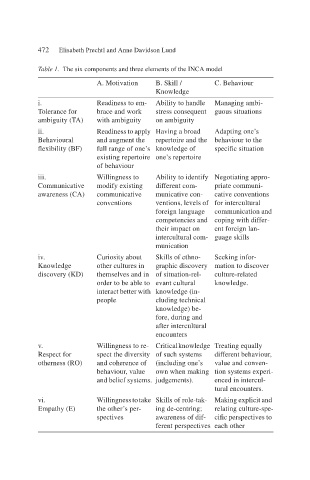Page 494 - Handbooks of Applied Linguistics Communication Competence Language and Communication Problems Practical Solutions
P. 494
472 Elisabeth Prechtl and Anne Davidson Lund
Table 1. The six components and three elements of the INCA model
A. Motivation B. Skill / C. Behaviour
Knowledge
i. Readiness to em- Ability to handle Managing ambi-
Tolerance for brace and work stress consequent guous situations
ambiguity (TA) with ambiguity on ambiguity
ii. Readiness to apply Having a broad Adapting one’s
Behavioural and augment the repertoire and the behaviour to the
flexibility (BF) full range of one’s knowledge of specific situation
existing repertoire one’s repertoire
of behaviour
iii. Willingness to Ability to identify Negotiating appro-
Communicative modify existing different com- priate communi-
awareness (CA) communicative municative con- cative conventions
conventions ventions, levels of for intercultural
foreign language communication and
competencies and coping with differ-
their impact on ent foreign lan-
intercultural com- guage skills
munication
iv. Curiosity about Skills of ethno- Seeking infor-
Knowledge other cultures in graphic discovery mation to discover
discovery (KD) themselves and in of situation-rel- culture-related
order to be able to evant cultural knowledge.
interact better with knowledge (in-
people cluding technical
knowledge) be-
fore, during and
after intercultural
encounters
v. Willingness to re- Critical knowledge Treating equally
Respect for spect the diversity of such systems different behaviour,
otherness (RO) and coherence of (including one’s value and conven-
behaviour, value own when making tion systems experi-
and belief systems. judgements). enced in intercul-
tural encounters.
vi. Willingness to take Skills of role-tak- Making explicit and
Empathy (E) the other’s per- ing de-centring; relating culture-spe-
spectives awareness of dif- cific perspectives to
ferent perspectives each other

